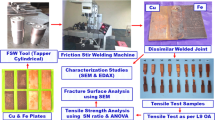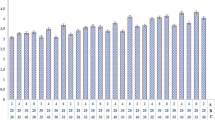Abstract
The welding seams procedure is widely used in the manufacturing industries for intermediary steps of the steel production or joints of parts of several manufactured products such as automobile, ships and aircrafts. The weld seams can be produced through a number of different arc welding processes, but the comparison of two different welding processes for the production of a quality weld seam is not trivial, and a quantitative method, which gives comparable parameters, is necessary to be developed. In this work, a method is proposed for comparing between two welding processes through the statistical study of the effects that two welding energy levels have on the selected output variables of each one. A 22 full factorial design of experiment was applied. The process responses are one-dimensional weld bead geometry (penetration, width and reinforcement), two-dimensional weld bead geometry (penetration area and reinforcement area), dilution and weld bead microstructure. The statistical analyses showed that the methodology presented is capable of determining objective parameters (statistically based) which can be useful in comparing and selecting a suitable process for a specific application. The comparison of the results between fluxed core arc welding (FCAW) and shielded metal arc welding processes reveled that both produced weld seams with the same penetration. Therefore, in this study, it was recommended the selection of the FCAW process at low energy level, which was able to produce larger width weld seams and improved microstructure quality, saving 30% of the energy consumption.
















Similar content being viewed by others
Abbreviations
- α :
-
Constant of proportionality for anode or cathode heating
- β :
-
Constant of proportionality for electrical resistance heating
- η :
-
Thermal efficiency factor
- A :
-
Reinforcement area
- B :
-
Penetration area
- CTWD:
-
Contact tip-to-work distance
- D :
-
Dilution
- DM:
-
Deposited metal
- DR:
-
Deposition rate
- E :
-
Welding energy
- E c :
-
Electrode composition
- E ex :
-
Electrode extension
- E fs :
-
Electrode feed speed
- E φ :
-
Electrode diameter
- H :
-
Heat input
- I :
-
Welding current
- L :
-
Arc length
- MR:
-
Melting rate
- MTM:
-
Metal transfer mode
- OF:
-
Operating factor
- P :
-
Penetration
- R :
-
Reinforcement
- S :
-
Travel speed
- SGc :
-
Shielding gas composition
- U :
-
Welding voltage
- U source :
-
Voltage set on power source
- W :
-
Width
References
Ravisankar V, Balasubramanian V, Muralidharan C (2006) Selection of welding process to fabricate butt joints of high strength aluminium alloys using analytic hierarchic process. Mater Des 27:373–380
Correia DS, Ferraresi VA (2007) Welding process selection through a double criteria: operational costs and non-quality costs. J Mater Process Technol 184:47–55
Kartal ME, Kang Y-H, Korsunskya AM, Cocksa ACF, Bouchardd JP (2016) The influence of welding procedure and plate geometry on residual stresses in thick components. Int J Solids Struct 80:420–429
Suban M, Tusek J (2001) Dependence of melting rate in MIG/MAG welding on the type of shielding gas used. J Mater Process Technol 119:185–192
Nathan SR, Balasubramanian V, Malarvizhi S, Rao AG (2015) Effect of welding processes on mechanical and microstructural characteristics of high strength low alloy naval grade steel joints. Defense Technol 11:308–317
Amer AE, Koo MY, Lee KH, Kim SH, Hong SH (2010) Effect of welding heat input on microstructure and mechanical properties of simulated HAZ in Cu containing microalloyed steel. J Mater Sci 45(5):1248–1254
Kumar S, Shahi AS (2011) Effect of heat input on the microstructure and mechanical properties of gas tungsten arc welded AISI 304 stainless steel joints. Mater Des 32(6):3617–3623
Alipooramirabad H, Ghomashchi R, Paradowska A, Reid M (2016) Residual stress–microstructure–mechanical property interrelationships in multipass HSLA steel welds. J Mater Process Technol 231:456–467
Yan W, Zhang H, Zhi-gang J, Hon KKB (2016) Multi-objective optimization of arc welding parameters: the trade-offs between energy and thermal efficiency. J Clean Prod 140:1–8
Sproesser G, Chang Y, Pittner A, Finkbeiner M, Rethmeier M (2017) Environmental energy efficiency of single wire and tandem gas metal arc welding. Weld World 61:733–743
National Electrical Energy Agency (ANEEL) (2007) Electrical Energy Atlas of Brazil, 3th edn. Brazil (in Portuguese)
Norrish J (2017) Recent gas metal arc welding (GMAW) process developments: the implications related to international fabrication standards. Weld World 61:755–767
Jorge VL, Gohrs R, Scotti A (2017) Active power measurement in arc welding and its role in heat transfer to the plate. Weld World 61:847–856
Garcia RP, Scotti A (2011) Uma metodologia para Análises Comparativas da Capacidade Produtiva entre Arames Maciços (MIG/MAG) e Tubulares (Eletrodo Tubular). Soldagem Inspeção 16(2):146–155 (in Portuguese)
Montgomery DC (2005) Design and analysis of experiments, 6th edn. Wiley, New York
International Institute of Welding—IIW doc. IX-1533-88 (1988) Guide to the light microscope examination of ferritic steel weld metals
ASTM International—ASTM E562-11 (2011) Standard test method for determining volume fraction by systematic manual point count
Barros Neto B, Scarminio IS, Bruns RE (2003) Como fazer experimentos: pesquisa e desenvolvimento na ciência e na indústria, 2a ed., Editora da Unicamp (in Portuguese)
Acknowledgments
The authors thank the Laboratory of Materials Characterization of Federal Institute of Southeast of Minas Gerais State—IF Sudeste MG, and the Laboratory for Welding Process Optimization of Federal University of Juiz de Fora—UFJF, for providing laboratorial support. The authors also thank the ESAB Company in Brazil for the consumables supply. This work was supported by FAPEMIG (article publication) and UFJF (undergraduate research scholarship program). We specially thank Professor Américo Scotti (Federal University of Uberlândia) for discussions.
Author information
Authors and Affiliations
Corresponding author
Additional information
Technical Editor: Lincoln Cardoso Brandao.
Publisher's Note
Springer Nature remains neutral with regard to jurisdictional claims in published maps and institutional affiliations.
Rights and permissions
About this article
Cite this article
Silva, G.C., de Castro, J.A., Filho, R.M.M. et al. Comparing two different arc welding processes through the welding energy: a selection analysis based on quality and energy consumption. J Braz. Soc. Mech. Sci. Eng. 41, 301 (2019). https://doi.org/10.1007/s40430-019-1804-x
Received:
Accepted:
Published:
DOI: https://doi.org/10.1007/s40430-019-1804-x




